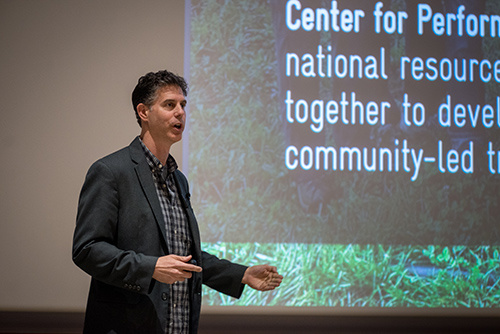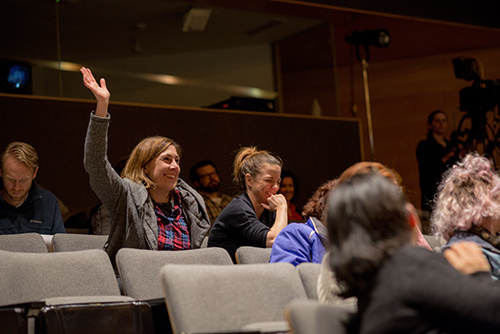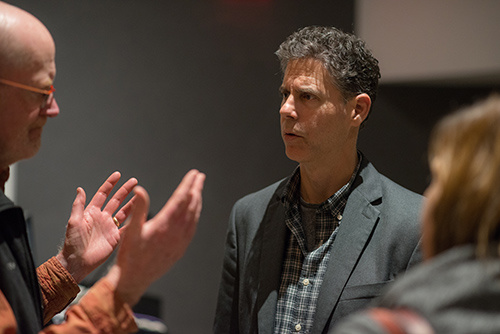
This transition from art as consumable to art as participatory is the core of Rohd’s work with Sojourn Theatre and its counterpart, the Center for Performance and Civic Practice. His experiences creating paradigm shifting theater and community engagement were the primary examples for his talk “Devising Civic Practice: Listening is the New Revolution.”
“The thing I feel passionate about as an artist is the potential every artist has to be collaborating in community with local partners to bring creative assets to these three needs: problem-solving, building intersectional coalitions, and envisioning inclusive futures,” said Rohd.
Rohd described the work of Sojourn Theatre over the years to “build bridges that are not just metaphorical” between conservatives and liberals, urban and rural dwellers, the young and old, and the economically wealthy and poor through the medium of theater. The Center for Performance and Civic Practice grew out of that work to help support the development of art/civic partnerships in other communities as well as to learn, document and share results.
Broadly, Rohd said, demand for community-based art is growing and funding structures for the arts have changed to support it. Now more than ever, artists have opportunities to bring the talents and skills that make them great artists—creative problem-solving, finding the connections between disparate things—and bringing them to bear on civic issues such as racial equity and economic justice.
Rohd drew a distinction between two ways to practice this type of artistic activism: social practice and civic practice.

He went on to describe a meeting he once had with a community leader who had been approached by six different artist groups who wanted something from the organization to complete a project (social practice) but who never bothered to ask what needs the organization had and how the artist might serve them (civic practice).
A broad swath of leaders from the Iowa City community were in attendance for the lecture including Iowa City Mayor Jim Throgmorton. Earlier that day, Rohd led a half-day workshop for faculty, staff, students, and community members in partnership with the Obermann Center for Advanced Studies, Division of Performing Arts, United Action for Youth, Riverside Theatre, and Hancher Auditorium.
In the Q&A after the talk, one participants asked Rohd if there were any examples of community-arts collaborations leading to meaningful policy change. Rohd recounted the 2014 “Crossing” street performance.
In Milwaukee, a group of economically distressed elderly people had been social isolated and confined to a single city block for years because the crosswalk lights changed too quickly for them to make it across the street safely. The group of community partners Rohd was working with came up with a whimsical theatric performance to assist an elder in crossing the street and draw public attention to the problem.
The performers grouped together to form a sailing ship complete with a captain, sails, signal flags and a loudspeaker that played songs like the theme from Love Boat, Gilligan’s Island, and Styx’s Sail Away. In the middle of the ship was a cabin, and a senior would walk in the cabin with any public official they could get to participate. Once the local media picked up the story, Rohd said, the mayor eventually came too.

Thanks largely to this theatrical spectacle, the crosswalk lights timers were changed. (To see the crossing in action, check out this video).
For a full listing of other events in the 2016-17 Creative Matters lecture series, please visit https://creativematters.research.uiowa.edu/.
The Creative Matters lecture series seeks to demonstrate that creativity is not only at the core of all research and discovery, but is also central to our human experience. The lineup of invited speakers includes artists, thinkers, builders, and doers who challenge conventional thinking about creativity, science, and artistic expression, borrowing from a range of influences and disciplines in their work.
The Office of the Vice President for Research and Economic Development provides resources and support to researchers and scholars at the University of Iowa and to businesses across Iowa with the goal of forging new frontiers of discovery and innovation and promoting a culture of creativity that benefits the campus, the state, and the world. More at http://research.uiowa.edu, and on Twitter: @DaretoDiscover.